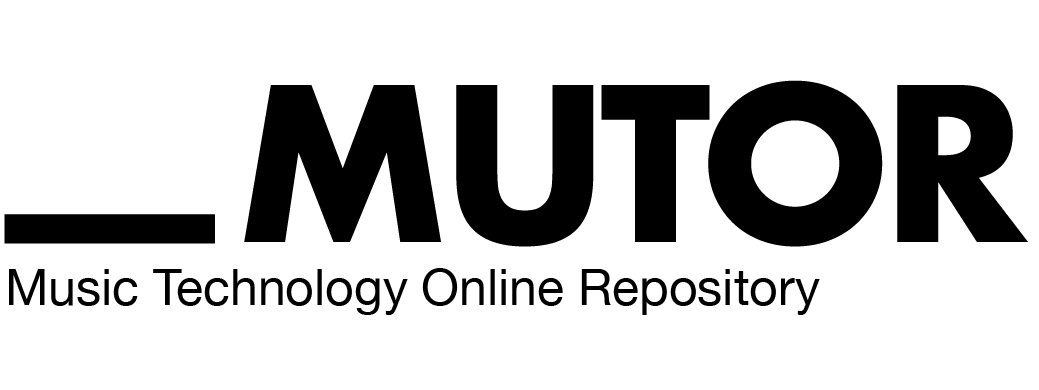Unit 4: Sound Installation Art. Experiments in the borderlands of music and visual arts
Synopsis
In the 20th century, working with sound is not the exclusive domain of musicians and composers. In Sound Installation Art the sonic elements turn out to be a space-consuming and sculptural material of the fine arts. In contrast to traditional music where time is the main concern, many sound artist focus on spacial aspects more than on time-based narrativity. Their “atmospheric soundscapes” often appear to be quasi-static, while the visitors are by no means passive consumers as in a classical concert hall: they move through the sonic environments at their individual pace and become interactive protagonists of their very own aesthetic experience. In sound installation art, the sounding atmospheres create moods and emotions constituting feelings and the subjective experience. In this introductory presentation historic and technological developments relevant for the emergence of interactive Sound Installations are discussed. In addition, dimensions of space and aesthetic are considered.
- Some characteristics. Instead of clear definition
- Some history: ‘cause it’s good to know your ancestors
- The early 20th century. things change
- After World War II: dissolving boundaries
- Co-Evolution of Technology and Music
- Tools for the creation of electronic sound
- The Sound Artist as Tinkerer
- Sound art in space: another excursion into history
- Aesthetics and Sound Art
- Atmosphere as concept of philosophy
- Sound Installation Art as Experiment
- Conclusion
- References
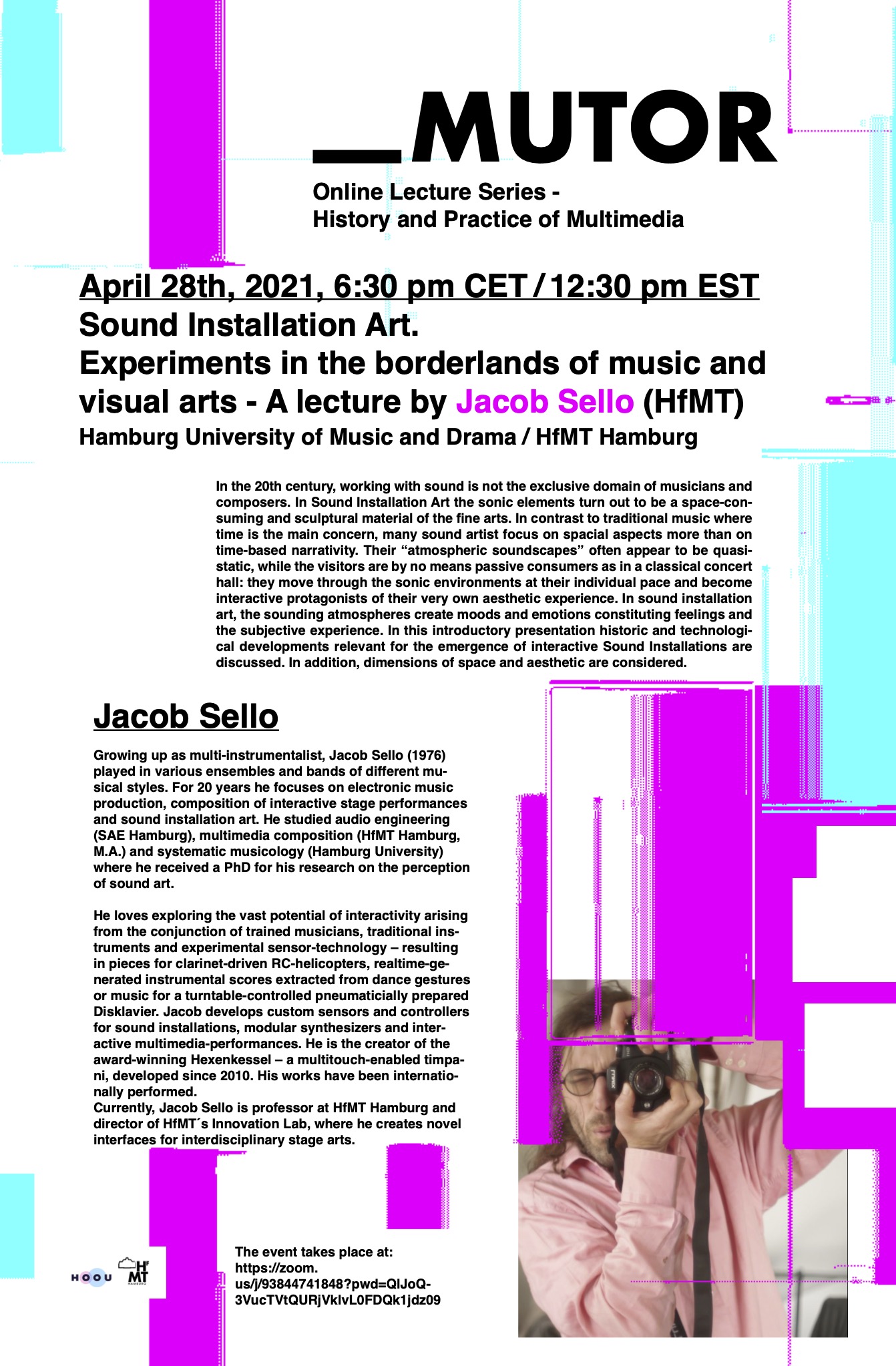
Some characteristics. Instead of clear definition
Giving a definition of sound installation art is difficult. This may be due to the fact that there are hardly any clear rules for this art form, as it is the case for most types of music. Also, the physical properties, that make up painting or sculpture, are missing. And even if it is possible to name a few typical characteristics, there is immediately a prominent counter-example.
However. Sound installations are often found at festivals for new music, in galleries and museums or in the public space. The conventional concert hall seems unsuitable for the presentation of sound installations. The sounds and noises, which are mostly electronically reproduced or synthetically generated, affect the recipient in conjunction with visual and architectural, spatial elements that can be explored. From a musical perspective, the visitors to the sound installation are given a new role: they are invited to move freely in the sounding space and to explore it with the personal temporality. The sound installation – unlike music – does not specify a narrative time structure, there is neither beginning nor end to the performance, but rather an almost static sonic experience that unfolds in space rather than in time. With their works, sound artists describe a field of possibilities in which the recipients can actively, sometimes interactively act, and create their own experience. This gives the audience the role of performers, they are less passive recipients than actors. The focus of the sound installations is – in contrast to works of (multi)media art – the auditory experience, listening.
Some history: ‘cause it’s good to know your ancestors
A golden thread can be followed through history from the beginning of the 20th century to contemporary sound art where the artistic avant-garde movements of the 1910s and 1950s play a prominent role. This context provides the historical humus on which sound art as we know it today could develop. Some major milestones shall be mentioned here.
Around 1920, the French composer Eric Satie had proposed a highly functional music with his Musique d’Ameublement (furniture music). This music should fit into a room as naturally as a piece of furniture. It should:
“soften the noise of knives and forks without drowning it out, without imposing itself. It should furnish the often annoying silence between guests. […] At the same time, it neutralizes somewhat the street noises that come into the play.” (Wehmeyer, 1998)(translation: J. Sello)
In doing so, Satie distributed the various instrumentalists around the performance space so that the music seemed to come from all sides at once.
Satie´s Musique d’Ameublement can be considered as important precursor of sound art as his ideas show astonishing parallels to approaches of the genre of sound installation art, which emerged about 50 years later. In both the atmospheric re-design of a specific space with the help of sounds is of major concern. And the effect of the sounds unfolds even if the listener does not consciously or attentively follow them, so that it is largely up to the recipient whether and to what extent he or she pays attention to the sound. At the first performance in 1920, Satie is said to have shouted (in vain), “Don’t listen! Go around! Entertain yourselves!” (Wehmeyer, 1998)
While Satie still wanted his sonic wallpapers and furniture music to be understood as purely functional and not at all as art, sound installations have their permanent place in contemporary exhibitions and museums of modern art. For example the ZKM (Zentrum für Kunst & Medientechnologie) in Karlsruhe hosts sound installations on a regular basis.
By today, sound art claims its place in art history and it has already produced its own differentiated history spanning more than half a century. Berlin based musicologist Helga de la Motte-Haber has devoted herself with particular dedication to working out the connections between music and the visual arts and to elaborating the significance of sound installation art in particular. Unfortunately, de la Motte-Haber´s extensive list of publications was mainly published in German language only.
According to Motte-Haber, three radical changes in the understanding of art motivated by the avant-garde movements of the 20th century are crucial as historical basis of sound installation art: First of all, the breakup of traditional boundaries between artistic genres since the mid-19th century is essential for the development of sound installations. Secondly, the change in the artistic conception of material is significant. This can be observed in the field of visual arts, but also as a development within the music of the 20th century. The new possibilities of electronic sound synthesis, sampling and processing and the resulting changes in compositional processes play an important role here. And third, the transformation of the traditional performance situation, the artist’s withdrawal from it, and the resulting new role of the audience form a crucial basis for the emergence of the sound installation as an art form. (Motte-Haber et al., 1999)
The early 20th century. things change
Until the beginning of the 20th century, the various arts were still essentially thought of and practiced independently of one another. Even Wagner’s opulent realizations of his Gesamtkunstwerk were rarely more than the mere juxtaposition of different means.
But with the early 20th century things began to change and several radical upheavals in the various art scenes all around the globe could be observed. The emerging industrialization and the various social and technological innovations of the time certainly had a strong impact on the artistic developments. Social tension was building up in different parts of the world, proceeding World War I. Different not necessarily connected groups of artists, later coined as anvant-garde, were involved in these major developments, mainly in the European metropolises.
Starting in Munich, a network of visual artists, writers, musicians and theater makers wanted to outgrow and break with traditions in their fields. Their group became known as Der Blaue Reiter (the blue rider), among the members were Wassily Kandinsky, Franz Marc and Paul Klee. Under the same title they published their almanac, a journal in which they exchanged radical ideas concerning abstract painting, atonal music, dadaism, non-western traditional arts, multimedia theater ideas of visionary proportions.
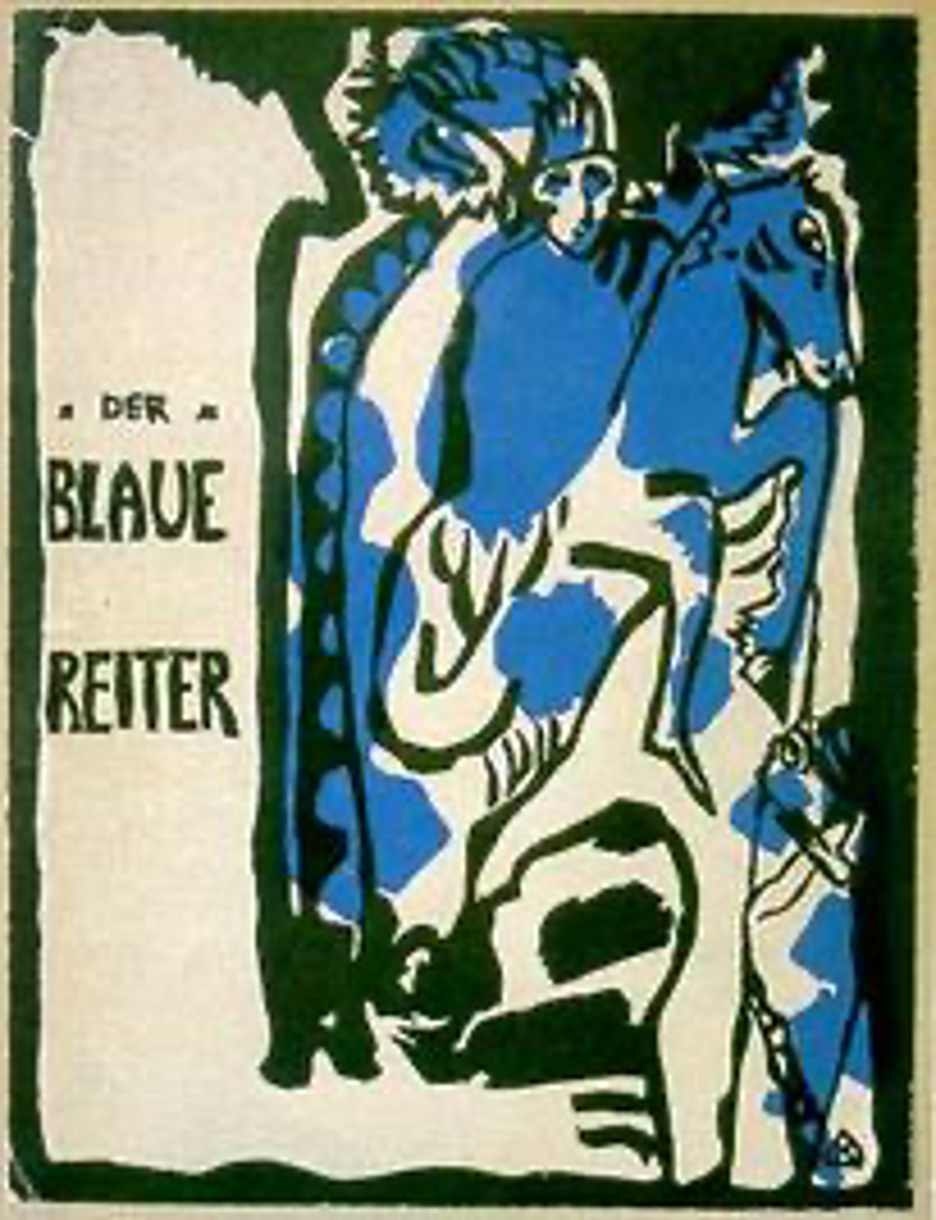

In 1913 Georges Braque and Pablo Picasso established the form of the artistic collage. They collected and combined a wide variety of materials to create new works: Newspaper clippings, fabrics or common objects of daily use such as paintbrushes were integrated into the pictural composition. Through such combination of painted and glued materials not previously used by artists, the idea of the artwork as a homogeneous whole created in a single medium was put to disposition. Also, everyday objects and materials were liberated from their original function, aesthetically re-evaluated and thus ultimately “capable of art”, becoming independent carriers of meaning. Within a few years, French artist Marcel Duchamp took this notion of art to its extreme: with his famous Ready-Mades, he elevated ordinary everyday objects to the status of artworks, signed and exhibited them. Whereas previously the artist’s material had been understood as a means of expression, Duchamp made use of finished industrial products and put the artistic idea and the concept in the center of the work.
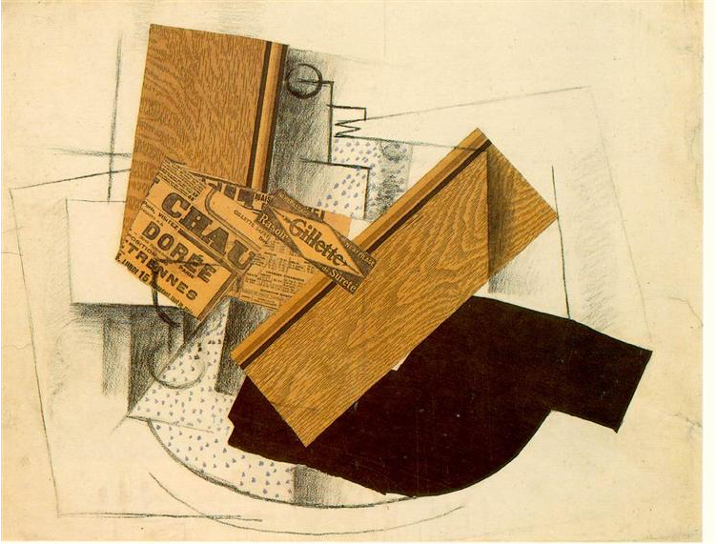
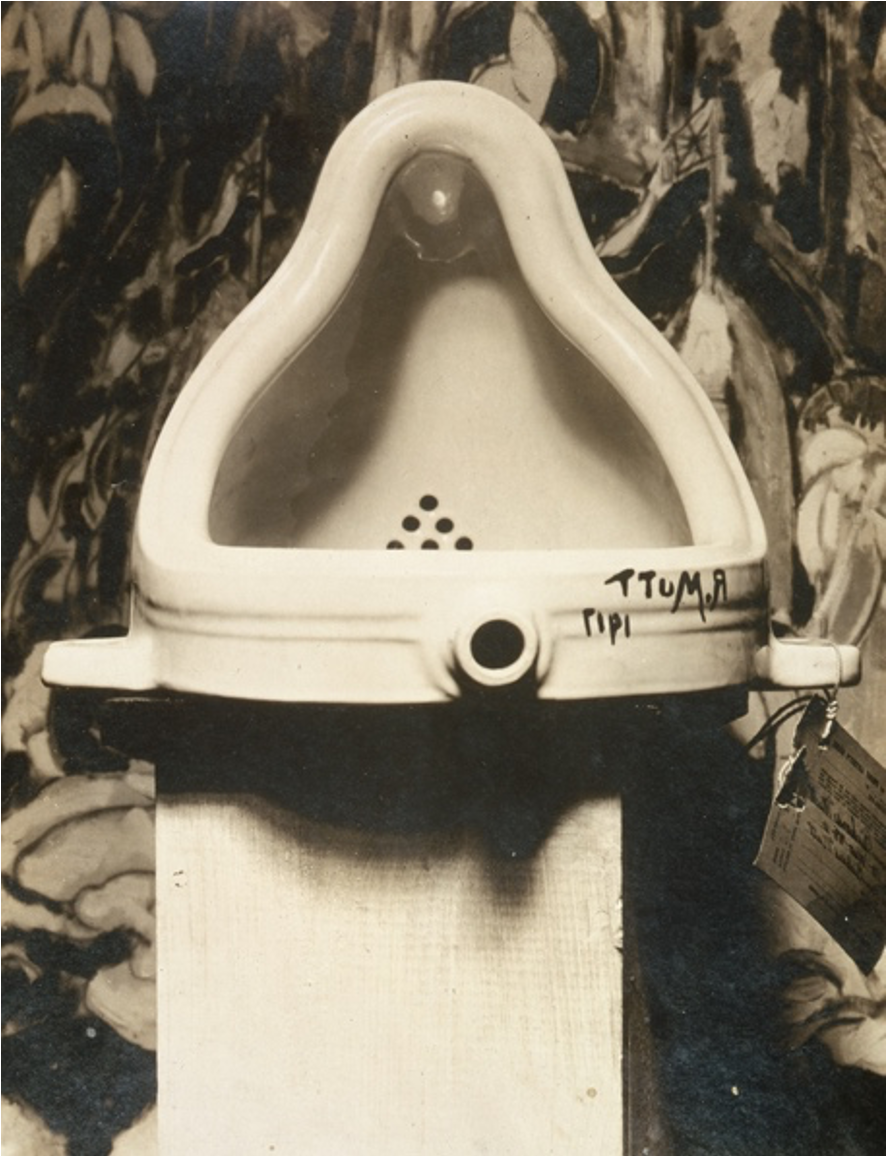
During the same time a group of artists around the Italian writer Filippo Tommaso Marinetti gathered in Italy in 1910, calling themselves Futurists – excited by the technological developments of their time and joyfully anticipating the future. Various painters, poets and composers such as Edward Varèse and Albert Doyen considered themselves to be part of this movement. On February 2nd, 1909, the front page of the Paris newspaper Le Figaro featured Marinetti’s Futurist Manifesto. This contained eleven programmatic theses that were intended to establish not only a new artistic movement, but also a culture that encompassed all areas of life. In the manifest Marinetti declared violence and war the “only hygiene in the world” and he vehemently opposed all traditions: “Put fire to the shelves of libraries! […] Divert the course of the canals to flood the museums! […] Seize the pickaxes, the axes and the hammers and tear down, tear down without mercy the cities!”. See full text (german, translation J. Sello)
With his Intonarumori Italian Futurist Luigi Russolo built 27 different mechanical sound generators and presented them in various concerts. He notated the music in a rather classical way (see figure 4.7)
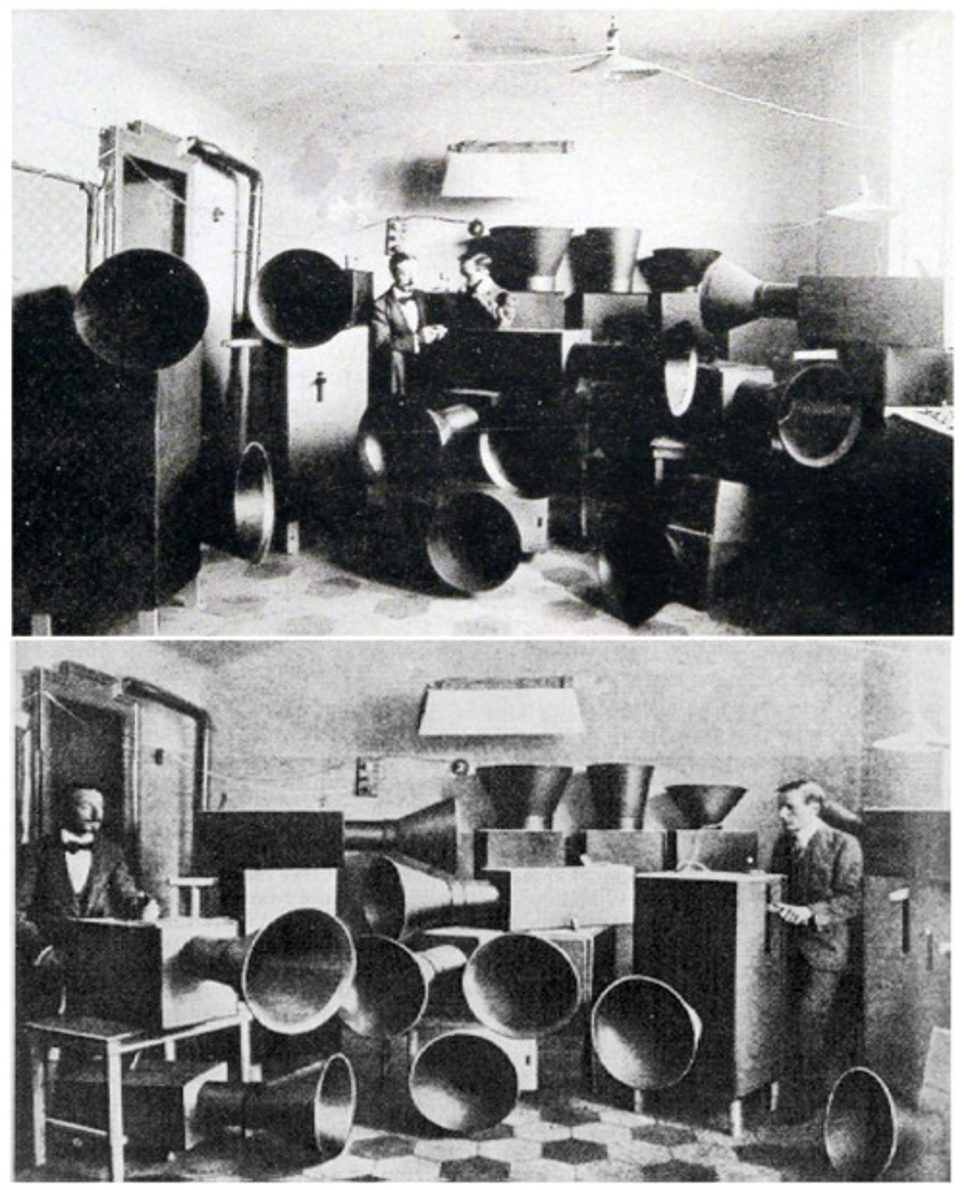

During those years, the Russian painter Wassily Kandinsky, member of Der Blaue Reiter, was trying to develop a grammar for art as a whole. Therefore, he was concerned with the transfer of formal principles from one medium to another. For example, he wanted to translate structures from music to painting: rhythm, timbre, dynamics, movement. In 1918 Kandinsky was involved in the founding of the Institute of Artistic Culture in Petrograd what is now St. Petersburg. This Institute is considered the forerunner of the famous Bauhaus. The Bauhaus was founded by Walter Gropius in Weimar after the end of the war. Wassily Kandinsky, Paul Klee, Lyonel Feininger, Lazlo Moholy-Nagy, Oskar Schlemmer and many other representatives of classical modernism taught there and developed an interdisciplinary artistic program that included design, architecture, painting, dance, music and theatre.
Teaching at Bauhaus Lazlo Moholy-Nagy proposed a new form of theater in 1925 with his text Theater, Circus, Varieté, which would utilize elements of shock and surprise. He had the idea of placing electric or mechanical sound generators in the auditorium. Hidden under the floor or under the seats, they would play music, noises or even speech. Between 1924 and 1925 Moholy-Nagy designed a piece entitled: Mechanical eccentricity. A synthesis of form, movement, sound, colored light. In addition, he made a score sketch, which shows the events on three stages including different projection screens. According to Motte-Haber (1999), this sketch already anticipates the score arrangements of the happenings that would emerge almost 30 years later, and this work may already be considered a mixture of performance and sound installation. (Motte-Haber et al., 1999)(p.52)
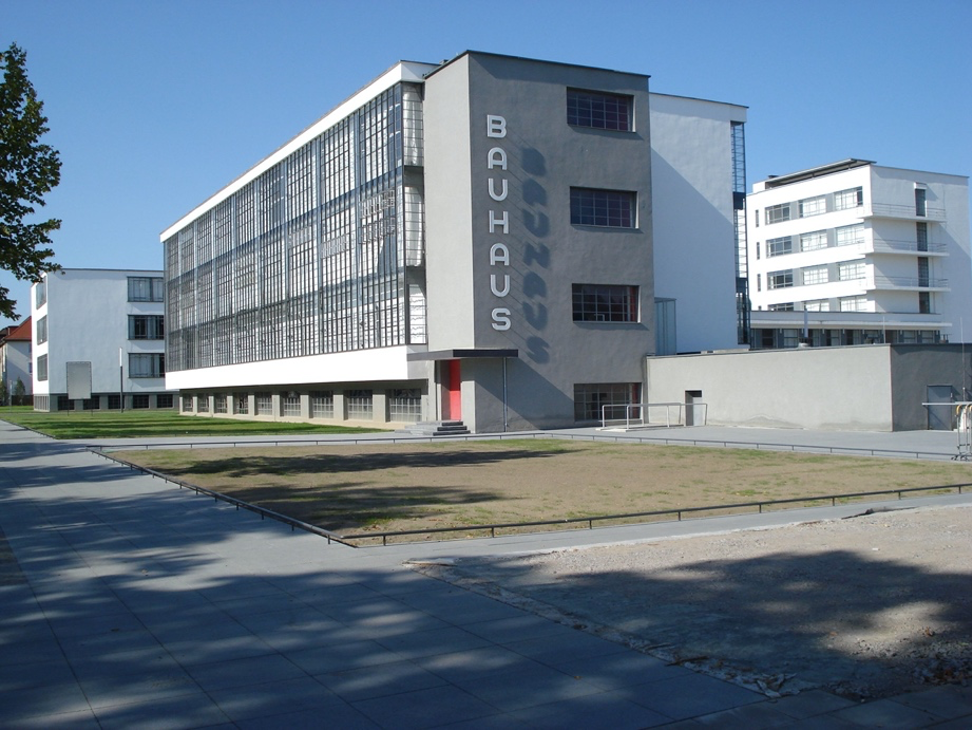
After World War II: dissolving boundaries
With the rise of Nazi-Germany and the upcoming war, artistic developments in central Europe came to almost complete halt. Several Bauhaus teachers and students immigrated, including -László Moholy-Nagy, Josef Albers and Walter Gropius. Moholy-Nagy went to Chicago where he founded the New Bauhaus (later: School of Design) in 1937. Joseph Albers joined the newly founded Black Mountain College in North Carolina. Until it was shut down in 1957, this school was the leading institute for interdisciplinary (mainly) artistic education, with teachers such as architect Buckminster Fuller or Albert Einstein, who was guest lecturer there in summer classes.

In 1948 American composer John Cage received a teaching assignment at Black Mountain College. As the author of various key works of New Music Cage is considered as one of the 20th century´s most influential composers. Additionally, he was an integration figure of the Happening and Fluxus movements and an important initiator and practitioner of sound installation art. At Black Mountain College, a wide variety of arts was brought together by Cage, for example in his 1952 Untitled Event, held in the school´s dining room: David Tudor played the piano, Merce Cunningham danced under Robert Rauschenberg’s White Paintings while slides and films were projected onto various screens. A poetry reading took place and Cage gave a lecture on Meister Eckhart. This so called happening lasted 45 minutes and was organized chronologically by a schedule created with the help of random operations.
Here, Cage dissolved the traditional frontal form of stage presentation by turning the audience into an integral part of the event and thus granting the recipient a new meaning in the context of art. So, in addition to breaking down media boundaries, the alteration of the audience’s perspective is its most characteristic feature, being a great influence to the sound installation art. However, since such happenings and performances didn´t give up the traditional role of the artist as performing actor on stage, it led into a different direction, namely to the now widely differentiated field of performance art.
While in happenings and Fluxus´ “concerts” the artists were still performers, who went on stage to make direct contact with the audience, in the following years the emergence of installation art was accompanied by the artist’s withdrawal from the performance situation. American sound artist Max Neuhaus was the first to coin the term sound installation to describe his project Drive-in Music (1967). He had installed several radio stations along a road with the same transmission frequency but different sounds, which were received differently by the passing cars, depending on their speed and direction of travel, so that an unique and individual sound progression was created.
Out of these not always linear developments within the visual arts and music, a new art form emerges, living in between the traditional genres of art: Sound Art. The boundaries of the individual genres within Sound Art appear fluid: often it is hard to decide whether a work should be categorized as sound sculpture, sound performance or as sound installation. In fact, it is rather rare to find works that could be described as pure sound installations according to the characteristics of an idealized type of sound installation listed in the introduction. This is mainly due to the cross-border character of this art form. In most cases, visual and architectural aspects play a role in the works and each artist sets the very own emphasis.
Co-Evolution of Technology and Music
For sound artists, technology is both instrument and tool. The way of working with it needs to be learned and developed. Meanwhile, every technology and each single tool brings its own workflow and functionality, which shapes and forms the workpiece in its own way. With his recent book Every Tool’s a Hammer (2019) American tinkerer Adam Savage explores the evolution of tools and their influence on one’s way of working. But this is by no means a novel phenomenon: The 20th century is characterized by the increasing mechanization of musical creation or by the “musicalization” of technology. Again and again, one comes across personalities who simultaneously assume the role of researcher and inventor as well as that of composer and musician. Lev Termen, Maurice Martenot and Friedrich Trautwein, for example, had a technical education that enabled them to construct new musical instruments (Theremin, Ondes Martenot, Trautonium), which they immediately utilized in their own compositions. Later, in the course of the progress of the computer technology, one meets personalities like Max Mathews (name giver for Max/MSP), Jean-Claude Risset or John Chowning (inventor of the FM synthesis), who were on the one hand programmers, on the other hand used the programs and procedures developed by them for the realization of their own music.
In short, the role of the composer changed with the entry of technology and media into compositional practice. In the 20th century, the composer’s workplace is no longer primarily the piano and the desk complete with music paper and pencil, but the compositional work is created in the “laboratory,” in the highly technical recording studio or –more recently– on the personal computer.
Like the electronically generated music, the sound installations draw from the almost infinite pool of new sounds that enriched western music in the course of the 20th century: from Russolo’s Intonarumori and the integration of everyday objects such as sirens and chainsaws into music, from John Cage’s prepared pianos to the sonic diversity resulting from field recording & sampling, as well as the electronic synthesis of entirely artificial sound and noise. In the historical context, the development of electronic music reveals reciprocal relationships between art and technology that can be described as co-evolution. The question of whether technical progress caused the innovations in art, or whether the cultural changes initiated by art first formed the preconditions for the development of new technologies, is comparable to the famous question of which came first - the hen or the egg. For example, the sudden availability of video equipment was hardly responsible for the emergence of video and media art in the 1960s. Rather, the avant-garde’s search for new means of artistic expression that would unfold their effect through the interplay of different senses. Thus, artists re-purposed the new possibilities of video technology for their happenings, Fluxus concerts, and environments. The new technology was merely an additional component of their intermedial works, but it ultimately provided the impetus for the emergence of new artistic genres such as multimedia and video art.
In the 1950s and 1960s, it was common practice to alienate existing technology, radio or measurement technology, for example, or even to develop new devices oneself. In contrast, today´s sound artists can draw from the almost unlimited pool of industrial tools for music production:
Tools for the creation of electronic sound
Sound synthesizers have been developed since the late 1950s, initially manufactured in costly small series by companies such as Moog, Buchla, Arp or Sequential Circuits, only available to few. Today, devices with similar functionality are comparatively cheap thanks to Asian mass production. Digital synthesizers and samplers have supplemented the range of available electronic sound generators since the 1980s. During the 1990s, standard computers have become powerful enough to completely take over the functionality of a well-equipped recording studio. And so, todays computers play a key role not only in contemporary music production, but also in sound installation art.
However, if we compare different works we see a large variety of systems: there are installations that “just” play back pre-produces sound loops. In contrast, there are generative installations, that are based on certain mechanisms that implement rule-sets for generating the musical content in real-time. As a third group, we find interactive installations that allow the audience to playful interact with the system. Also, there are performative installations, where the artist could be part of the presentation, maybe only for a special event at a vernissage, for example.
There is a wide range of different tools used for the realization of sound art. In early days often analog synthesizers or magnetic tapes were used, where several tape loops of different lengths were played at once but not synchronized, so they would create an everchanging sonic result. Today, there are various flexible software tools, such as the graphical programming environments Max/MSP or open-source Pure Data. Such graphical programming environments allow the user to quickly prototype software that, for example, creates random processes, or analyzes input signals and, on this basis generates sounds, interactive visuals or automates studio hardware. Such a program could also communicate through the internet or implement AI algorithms… everything goes. In addition, easy-to-program microcontrollers such as the Arduino family can be used to interact with the physical world by recording and controlling processes outside the computer. A variety of sensors can be used to enable real-time interaction, control lights, motors and almost unlimited other devices. There are unprecedented possibilities for implementing your own ideas!
As in the early days of electronic music, among sound installation artists we often find a rather unconventional approaches: creation outside the industrial/commercial pathways. Many sound artists create their own sound generators and invent their very own and unique technical systems.
The Sound Artist as Tinkerer
This artistic process, in which the possibilities of existing technologies are tested and adapted to one’s own needs, in many cases give rise to ideas that inspire new works – often through the unconventional use far off the handbook. Thus, according to German musicologist Barbara Barthelmes (2004), this new type of composer/artist can be identified as tinkerer or maker (germ.: Bastler), whereby the negative connotation of this term, the hobby-like and non-professional, is not meant. (Barthelmes, 2004)
Exploration and experimentation is the tinkerer´s prime strategy, the free use of technology, regardless of its original purpose, done with the aim of developing one’s very own, new and individual artistic technique. The internet provides the necessary network and platform for communication: under the acronym DIY (Do it Yourself), a community of like-minded people has emerged to share their individual insights and procedures freely and free of charge. On the one hand, the tinkerer’s way to approach problems shows parallels to the Dadaist´s idea of the found object (objet trouvé) and, on the other hand, it ties in with the Futurists’ goal of bringing together everyday´s technology and art. Thus, a 1922 Futurist manifesto states:
“We Futurists force the machine to tear itself away from its merely practical function, to rise to the spiritual and disinterested life of art, and to become a very high and fruitful source of inspiration.” (Prampolini et al., 1922)
Sound art in space: another excursion into history
In the 16th century various works for multiple choirs were composed in the church musical tradition for the Basilica di San Marco in Venice. Here, the multi-aisle architecture of the dome was played by two opposing organs. Different groups of instruments or choirs were then placed on different galleries, so that a first spatial music was staged – almost 500 years ago.
But the real integration of physical space, as integral part of musical composition, as a “composable parameter” of music, did not emerge until the 1920s with Edgar Varèse’s instrumental spatial compositions, such as Integrales (1926), which was conceived as a “projection into space”. Or with compositions by Arnold Schoenberg: in his (unfinished) oratorio Jakobsleiter (Jacob’s Ladder), begun in 1915, Schoenberg envisioned remotely played music (orchestra and choirs) to be conducted through a system of pipes to various different locations in the performance space. With the new technological possibilities of electronic sound production and control in the 1950s, these ideas were further investigated: The early approaches to spatialization, as this is called today, lead into a structural element of Serial Music with several compositions focusing on such spatial aspects. Stockhausen spoke in an essay (1961) of the “rediscovery of the function of space”.
In order to be able to position electronic sounds in physical space, a playback system is needed with at least two loudspeakers. Stereophonic speaker setups create the impression of a sound source being located centrally between the (two) speakers, when the sound intensity of both speakers is identical. Due to volume differences of the two loudspeakers, this so-called phantom sound source shifts in the direction of the speaker with the higher amplitude. Accordingly, it also is possible to simulate simple movements of the sounds. However, the sound objects remain always on a line in between the speakers. In consequence, French composers Pierre Schaeffer and Pierre Henry used reproduction systems with more than two loudspeakers for their musique concrete as early as 1950. For example in their work Symphonie pour un Homme Seul (1951) four speakers were placed on the front left and right, as well as behind and above the audience. Around the same time, in the U.S. compositions were being created that were reproduced by four to eight loudspeakers placed in a circle around the audience (a setup that is still quite common). Among these compositions were Williams Mix (1952) by John Cage and Intersection (1953) by Morton Feldman, both protagonists of the American so called Tape Music scene. Only a few years later, Karlheinz Stockhausen created his works Gesang der Jünglinge (1956) and Kontakte (1960), which were designed to be played back by a newly developed 4-channel quadraphonic tape system. Here, the four loudspeakers were set up in a square around the audience and, in contrast to earlier systems, could be controlled synchronized in time, so that complex sound movements could be realized.
At the 1970 world exhibition EXPO in Osaka (Japan) Western Germany´s representative pavilion was a spherical concert hall, the so called Kugelauditorium, built by architect Fritz Bornemann. The hall was equipped with a 360° speaker setup controlled in 50 independent groups. Stockhausen was invited to perform his music here (electronic and instrumental with 19 musicians on site), as well as other composers such as Boris Blacher or Bernd Alois Zimmermann. During the 180 days of exhibition more than one million people experienced this futuristic sound show. It was the second visionary concert space at the EXPO world exhibition built for the realization of the ideas of the musical avant-garde, after the legendary Philips pavilion designed by Le Corbusier at the 1958 EXPO in Brussels featuring the Poème électronique by Edgard Varese.
Today, sound artists use a wide variety of methods for the acoustic projection or spatialization of sound. Some artists use state of the art technology, such as wave field synthesis systems or multi-speaker domes utilizing higher-order ambisonics algorithms or alike for the spatial distribution of their sounds. In others pieces rather unconventional loudspeaker setups are created, often consisting of numerous little speakers, sometimes in quite graphical arrangements, as in the works by Canadian sound artist Robin Minard or Berlin-based sound artist Stefan Roigk.
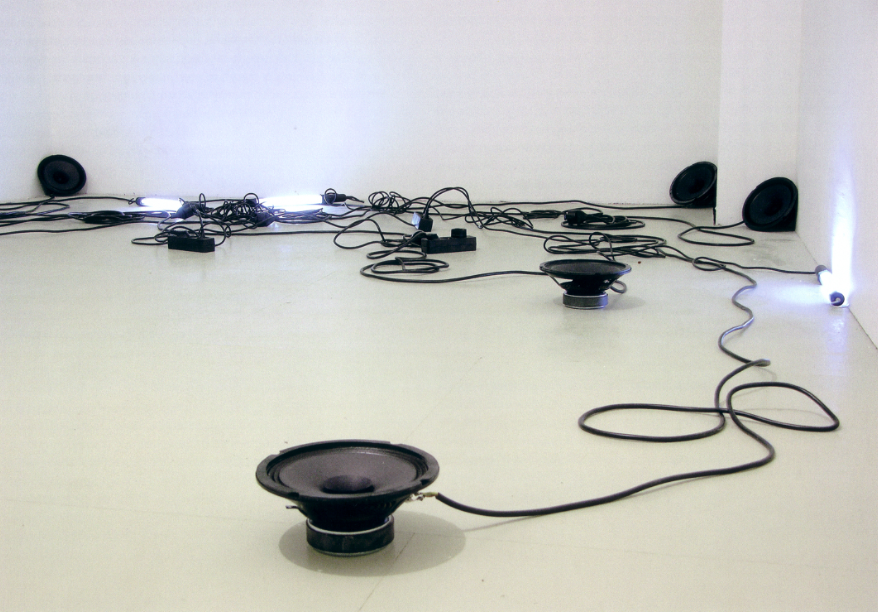
In most cases the physical performance space is considered as integral component of the artistic work. Thus, often sound installations are developed site-specifically: they are designed for the respective performance space, often establishing a contextual reference.
Aesthetics and Sound Art
The sound artist´s topics, techniques and motivations are manifold – but working with the exhibition space and its atmosphere appears to be of central concern to many artists. Canadian sound artist Robin Minard talks about “conditioning or coloring of space” (Minard, 1999)(p.63), when he refers to his idea of an aesthetic transformation of a found atmosphere. With his sound installations Minard creates almost static soundscapes projected into the room with the intention to modify or intensify the space´s basic mood. Also, by adding the additional sound layers he is able to mask disturbing noises.
These aspects, and especially the idea of masking noise sources, are central ideas of HfMT´s Healing Soundscapes project. For this project, conducted in collaboration with the Hamburg University´s Hospital (UKE) and other academic partners, various sound installations were developed and installed in different waiting rooms with the intention to improve the acoustical environment in a hospital setting.
The term soundscape used for this project was coined in the late 1970s by Canadian sound artist Murray Schafer: In his famous book The Tuning of the World he describes soundscapes as layers of acoustic noise, omnipresent in the world, constantly growing especially in the cities. Luckily, in the course of everyday mostly purposeful listening, such sound layers are usually ignored, and remain in the subconscious: the human sense of hearing is evolutionarily designed in such a way that we always try to assign a sound to its origin and, due to our distinct ability to localize sound, also deduce where it comes from. The abstract, often electronically generated soundscapes and noise layers of the sound installation, mostly lack any association to a natural origin: categorical assignment of a musical sound to a certain instrument usually does not work here. And through the sound transmission by means of loudspeakers, the sounds are decoupled from their source. We do no longer hear “something” in the same way that we hear, for example, a car driving by or a telephone ringing, but we just hear – in the broader sense of pure listening
The German philosopher Martin Heidegger described this form of unintentional hearing as “abstract”:
“We never […] hear, for example, tones and noises, but we hear the storm whistling in the chimney, we hear the three-engined airplane […]. In order to hear a pure sound, we must listen away from things, withdraw our ear from them, […] hear abstractly.”(Heidegger, 1936)(p.18, translation: J. Sello)
Atmosphere as concept of philosophy
German philosopher Gernot Böhme, representative of the philosophical movement New Phenomenology, describes such a form of listening, which is no longer purposeful nor directional, as characteristic and necessary for the perception of acoustic atmospheres. In doing so, he speaks of “hearing as such” (German: “Hören als Solches”). Böhme has devoted himself to describing atmosphere as a category of aesthetics for more than two decades, thereby he criticizes aesthetics as a theory of the artwork, which has degenerated into a means of forming judgments of art criticism, into a theory of taste. Aesthetics had thus detached itself from its original conception as a theory of perception and sensual cognition, as it had been developed in the mid-18th century by Alexander Gottlieb Baumgarten. Consequently, Böhme introduces and uses the term Aisthetic as reference to the Greek term aísthesis with it´s etymological source of “sensual perception”. (Böhme, 2001)(p.40-48)
In several publications Böhme introduces the atmosphere as the central concept of the New Phenomenology and he promotes a definition of the atmosphere, according to which it is to be understood as relationship between the environmental qualities and the iundivisual pre-condition. Thus, the properties and qualities of the space and the objects within it (including light, sounds, temperature, scents…) always affected their surroundings, radiating their qualities and thus contribute to the overall atmosphere of the surrounding space. Accordingly, sound is only one particular component of a perceived atmosphere. The perception of an atmosphere results from the interplay of all different sensory modalities. But its subjective perception and evaluation is shaped by the individual´s emotional state – the same atmosphere could be perceived differently if one is tired or angry, hungry or relaxed. Therefore, Böhme calls the atmosphere a typical intermediate phenomenon (Zwischenphänomen), since it describes a relationship between subject and object: On the one side there is the environment, which radiates its specific (objective) mood quality. On the other side stands the recipient with her or his subjective perception and the individual mental precondition. On the one hand, this “in-between” makes the atmosphere special; on the other hand, it makes it theoretically difficult to grasp. It appears to be blurred, as result from the interaction of the recipient´s subjectivity and the objective environment, quasi-objective”. (Böhme, 2001)(p.62)
Accordingly, Böhme describes interior architects, stage designers and musicians, who produce, for example, the background music known as Muzak for department stores, train stations or hospitals, as aesthetic workers. These people specialize in re-tuning spaces by modifying the existing atmosphere. “If an interior designer, for example, equips a room with sea-green wallpaper, then he is not, after all, concerned with producing walls with that color, but with creating a spatial atmosphere. If a sales practitioner in a supermarket lets a certain music sound, she does not, after all, bring a musical work to the ear, but wants to create a sales-favorable mood.” (Böhme, 1995)(p.87). From this perspective, it appears to be rather common to artificially (or artistically) produce very specific atmospheres. In consequence, there is a similarity of sound artists with interior architects, stage designers and sales strategists: they all, as aesthetic workers, manipulate the found atmosphere of places, by intensifying the atmosphere, with the help of added sounds and noises, subtle change it or completely overhaul what they´ve come across.
However, Böhme’s work does not yet allow any conclusions to be drawn about the specific impact of certain sounds on the resulting atmosphere and the accompanying subjective feelings and state of mind. This perceptive part must always remain subjective and unique. Nevertheless, the atmospheres in sound art can be influenced and artistically shaped to a great extent by acoustic means. It is clear from various empirical studies that there is no uniform meaning of music for humans. Still, it is fundamentally questionable whether the same music has a similar emotional effect on different listeners: “If one wants to get to the bottom of the effect of music, the question should not be how music affects people, but rather: Which music has which effect on which people under which conditions?”. (Hesse, 2003)(p.3, translation: J. Sello)
Sound Installation Art as Experiment
It is an open question of whether the multi-layered impact on the recipient of sound art is homogenously perceived by different persons – do we hear the same thing? This would be shown, for example, if a verbal description of a perceived atmosphere turned out to be similar for different test persons. This could then be considered as evidence for that the atmosphere indeed could be regarded as quasi-objective, as it is proclaimed by Böhme. If so, atmosphere would be highly relevant for research on the perception of sound art and music in general. Here, it helps a lot that we are used to exchange ideas about atmospheres: everyday language offers an astonishingly rich vocabulary to describe atmospheres. This then also raises another question: does the experience of the recipients coincide with the assessments and intentions of the sound artist? Does the recipient perceive it in a similar way as intended by the artist, as aesthetic worker? Is the atmospheric “intention” communicated? Or should we better assume an unpredictable, individual and completely subjective experience of sound installation art? The latter would suggest that the personal experience in the sound installation is always unique and completely subjective.
Contemporary music events are often advertised as “experiment” or as experimental setting challenging the audience´s perception. And in recent years, the idea of artistic research has become more prominent in German academia, especially in arts schools and music conservatoires. Students are encouraged to do experimental artworks, explore new artistic strategies, concepts and settings to gain some sort of insights from their artistic practice. But very often the outcome of such “experiments” is more or less ignored or seems to be considered less interesting than the experiment itself. In many cases all you get as indicator is applause, and even that is often given only because most audience members tend to be polite.
When studying Systematic Musicology at the Hamburg University I decided for my dissertation (2014) to look into those questions raised above and for this, I took the idea of experimental settings in sound art more literally. Consequently, I designed a empirical study as integral part of an interactive sound installation, utilizing a classic tool of experimental psychology: the questionnaire.
While the artistic part was treated to be merely irrelevant for my study (the sound installation I designed myself for practical reasons was considered as interchangeable stimulus) the use of established statistical methods borrowed from psychology and social sciences helped me to gain some insight in perception of acoustic atmospheres and to find answers to my questions. By analyzing the detailed answers of 100 probands it could be shown that there indeed was an intersubjective commonality in perception and verbal description of sonic atmospheres. Furthermore, it could be shown that the perceived atmosphere would indeed correlate with the artist´s assessment and intention. Certain groups (professional musicians and artists) did show ratings rather close to those of the sound artist (me in this particular case) indicating that these people would show a higher-than-average competence in perception and/or description of the atmosphere. One possible explanation is, that the expertise would be connected to long term training in reflection on and articulation of such matters. Though, a causal linkage seems rather obvious but with only 100 test persons not proven.
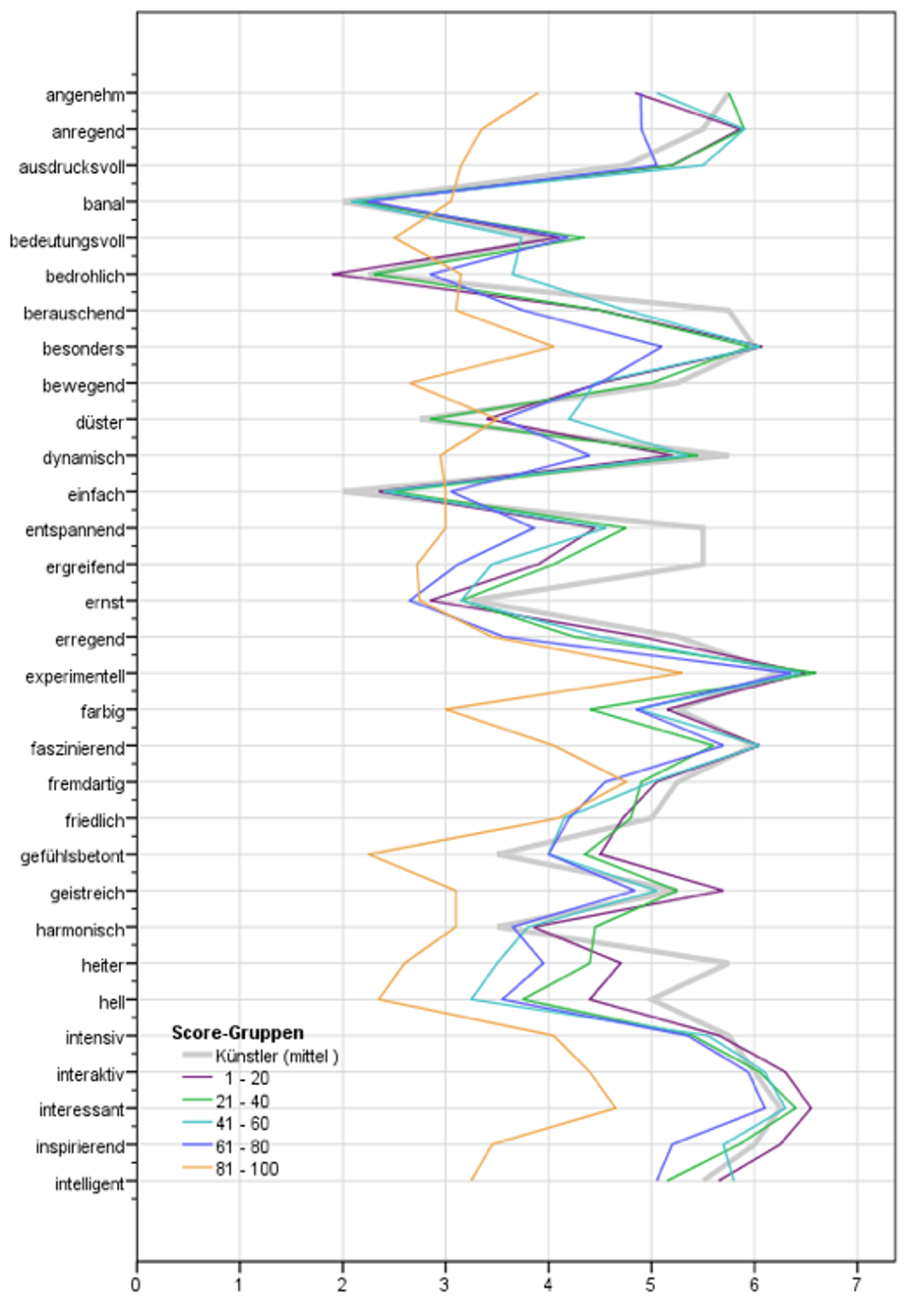
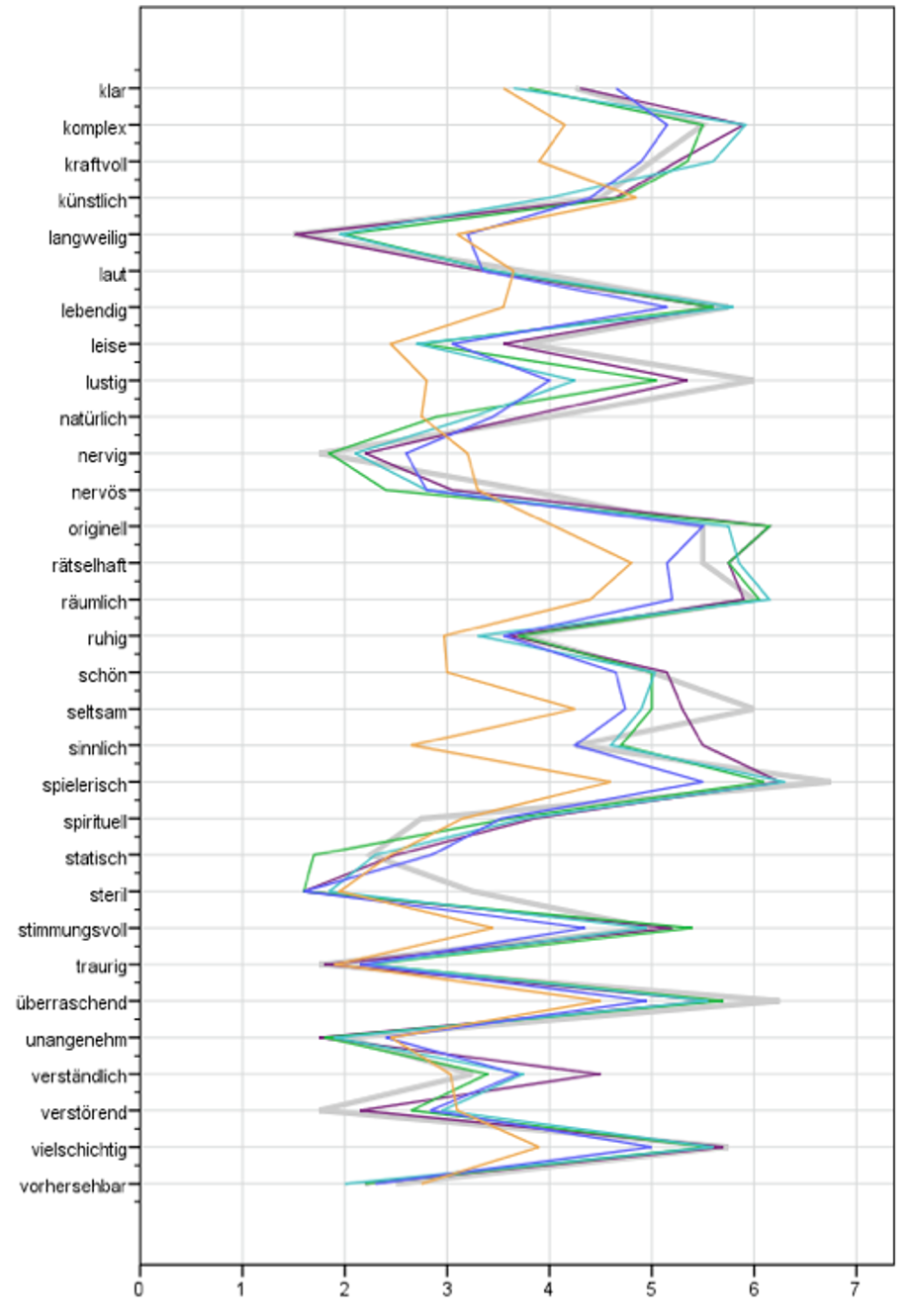
Conclusion
Still, after more than half a century of artistic practice, sound installation art appears to be an exciting genre in the borderlands of contemporary music and visual arts. Especially the open format and the unbounded freedom for unique artistic expression offer vast possibilities and chances. There is less pressure for the artist compared to traditional music, as the work doesn´t need to be presented “on the spot” as music on stage. Instead, sound installations can be developed more as process, constantly being optimized and adapted to certain conditions and requirements. Sound installations also offer very attractive setting for research: in the installation setting it is, for example, no problem to conduct a survey using an extensive questionnaire. While in a concert hall this would most likely be a very disturbing factor, in sound art it can become an integral component of the artistic situation, part the artwork.
References
- Barthelmes, B. “Experimentieren, Basteln, Gestalten, Inszenieren. Wandlungen des künstlerischen Selbstverständnisses”. Motte-Haber, H. de la, et al. (ed.): Musikästhetik, im Handbuch der Systematischen Musikwissenschaft, Bd. 1, Laaber Verlag, Laaber. 2004.
- Böhme, G. “Atmosphäre”. Essays zu einer neuen Ästhetik, Suhrkamp, Frankfurt/M. 1995.
- Böhme, G. “Akustische Atmosphären. Ein Beitrag zur ökologischen Ästhetik”. Institut für Neue Musik und Musikerziehung (ed.): Klang und Wahrnehmung. Komponist – Interpret – Hörer, Schott, Mainz u a.. 2001.
- Heidegger, M. “Der Ursprung des Kunstwerkes”. Reclam, Ditzingen 2008. 1936.
- Hesse, H. P. “Musik und Emotion. Wissenschaftliche Grundlagen des Musik-Erlebens”. Springer, Wien/New York. 2003.
- Minard, R. “Klanginstallationen. Neue Wirklichkeiten schaffen”. Schulz, B. (Hg.): Robin Minard. Silent Music. Zwischen Klangkunst und Akustik-Design . Kehrer Verlag, Heidelberg. 1999.
- Motte-Haber, H. de la & et al. “Klangkunst. Tönende Objekte und Klingende Räume”. Handbuch der Musik im 20. Jahrhundert, Bd. 12, Laaber Verlag, Laaber. 1999.
- Motte-Haber, H. de la. “Musik und Bildende Kunst. Von der Tonmalerei zur Klangskulptur”. Laaber Verlag, Laaber. 1990.
- Kandinsky, W. & Franz, M. “Der Blaue Reiter, dokumentarische Neuausgabe v. Klaus Lankeit”. Piper Verlag, München. 1965/1912.
- Prampolini, E. & Pamimaggi, I. & Paladini, V. “The Mechanical Art”. . 1922.
- Savage, A. “Every Tool Is A Hammer”. Simon and Schuster, New York. 2019.
- Schafer, R. M. “Tuning of the world. Toward a Theory of Soundscape Design”. University of Pennsylvania Press, Philadelphia. 1977.
- Sello, J. “Die Klanginstallation. Ein interdisziplinäres Versuchslabor zwischen Kunst, Musik und Forschung”. Verlag Dr. Kovač, Hamburg. 1998.
- Wehmeyer, G. “Erik Satie”. Rowohlt Verlag, Hamburg. 1998.
